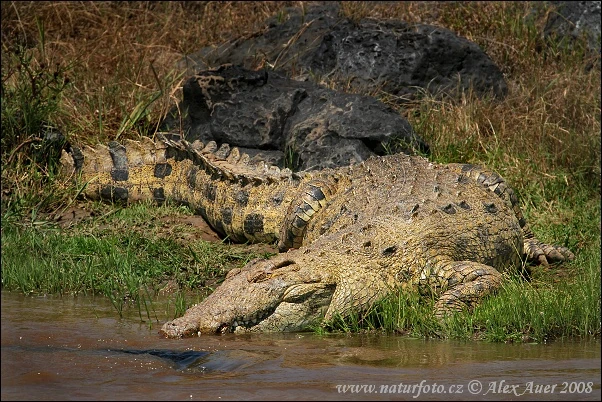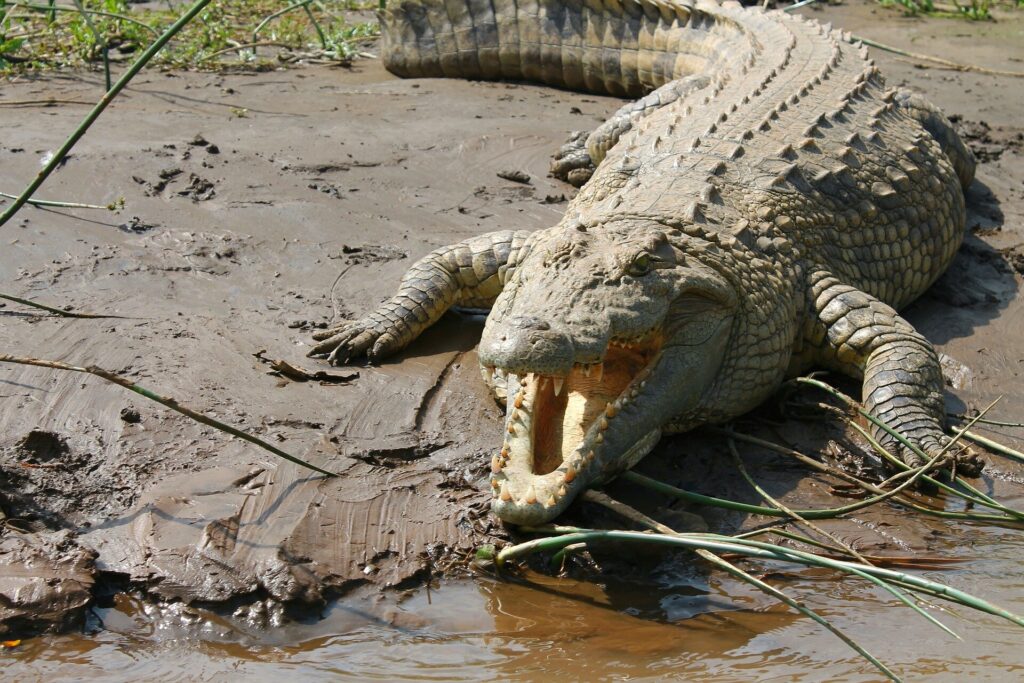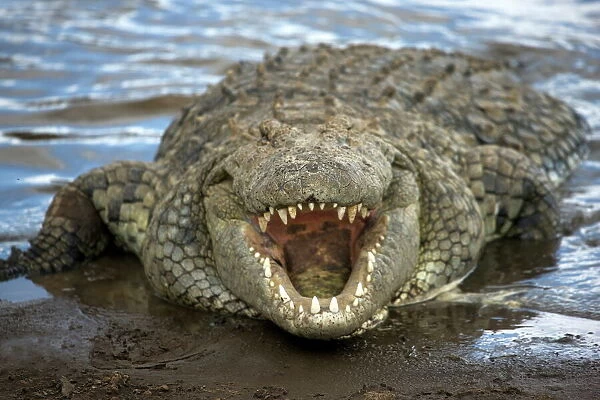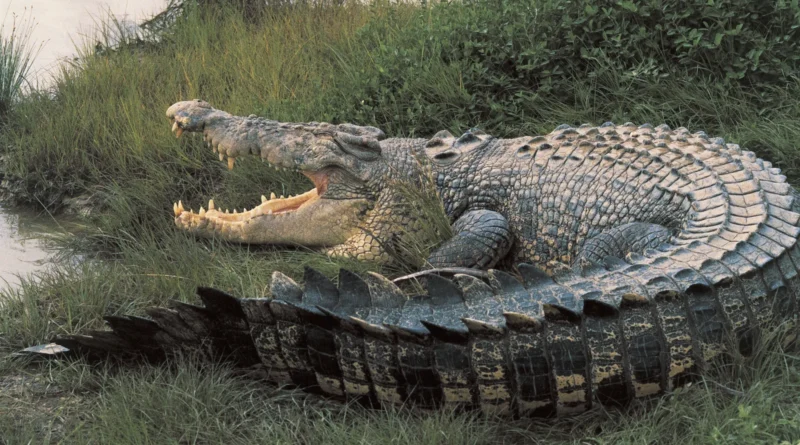Nile Crocodile Endangered Species
Nile Crocodile Endangered Species The Nile crocodile (Crocodylus niloticus), one of the most iconic reptiles of Africa, is a remarkable species known for its immense size, power, and important role as an apex predator. These crocodiles, once thriving across a wide range of African wetlands, are now facing increasing threats that could push them toward endangerment. This article explores the challenges Nile crocodiles are facing and the ongoing conservation efforts to preserve their existence.
Understanding the Nile Crocodile

Physical Characteristics
Nile crocodiles are among the largest reptiles in the world, with males reaching lengths of up to 20 feet and weighing more than 1,600 pounds. Their muscular bodies are covered in thick, armored scales that provide protection from predators and rival crocodiles. Equipped with powerful jaws and sharp teeth, Nile crocodiles are designed for hunting. Their coloration, typically dark green or gray with lighter underbellies, allows them to blend seamlessly into their aquatic environments.
Here’s a table summarizing key points from the article for easy reference:
| Topic | Key Information |
|---|---|
| Scientific Name | Crocodylus niloticus |
| Physical Characteristics | – Length: Up to 20 feet – Weight: Up to 1,600 lbs – Color: Dark green/gray with lighter underbellies |
| Behavior & Ecology | – Apex predator – Ambush hunter – Social species with complex behaviors |
| Current Range | Sub-Saharan Africa (e.g., Uganda, Kenya, Tanzania, Botswana, South Africa) |
| Historical Range | Previously covered a broader range across Africa, including parts of the Nile River and North Africa |
| Threats | – Habitat loss due to urbanization and agriculture – Poaching for skins and meat – Human-crocodile conflicts – Climate change |
| Conservation Efforts | – Protected under CITES – Wildlife reserves in South Africa and Botswana – Anti-poaching measures and sustainable farming for crocodile products |
| Success Stories | – Population recovery in some areas like South Africa and Zimbabwe due to effective conservation and management |
| How to Help | – Raise awareness about their ecological role – Promote sustainable tourism and farming – Engage local communities in conservation efforts |
| Conservation Importance | – Maintaining the balance of ecosystems as apex predators – Vital for controlling populations of fish, birds, and mammals |
This table provides a concise overview of the most critical points from the article. You could incorporate it into your blog as a quick reference for readers. Would you like to modify or expand the table in any way?
Behavior and Ecology
As apex predators, Nile crocodiles play a crucial role in maintaining the balance of ecosystems by controlling populations of fish, birds, and mammals. They are opportunistic hunters, known for their ambush tactics. Crocodiles wait patiently in the water, nearly invisible, until prey comes close, then launch a swift and deadly attack. Nile crocodiles are also highly social animals, often living in groups, especially during basking or nesting seasons. They are known to exhibit complex social behaviors, such as cooperating during hunting and displaying parental care.
Habitat and Distribution

Current Range
Today, Nile crocodiles are primarily found in sub-Saharan Africa, inhabiting rivers, lakes, marshes, and mangrove swamps. Countries such as Uganda, Kenya, Tanzania, Botswana, and South Africa still have significant Nile crocodile populations. However, their habitats are becoming increasingly fragmented due to human activities.
Historical Range
Historically, Nile crocodiles had a much larger range, covering vast regions of Africa, including parts of the Nile River and areas of North Africa that are now desert. Over time, their populations have declined, and their habitat has shrunk due to human encroachment, urbanization, and environmental degradation.
Why Are Nile Crocodiles Considered Endangered?

Habitat Loss
The primary threat to Nile crocodiles is habitat loss. As human populations grow, wetlands and rivers are drained or altered for agriculture, infrastructure, and urban development. This not only reduces the space available for crocodiles but also disrupts their food supply and nesting grounds.
Poaching and Hunting
Nile crocodiles have long been hunted for their skins, which are highly valued in the leather industry for making luxury goods like bags, belts, and shoes. Despite regulations, illegal poaching still occurs in many regions. Additionally, their meat and body parts are sometimes used in traditional medicine or as delicacies, further endangering the species.
Human-Crocodile Conflicts
Nile crocodiles are often feared by local communities because of their occasional attacks on livestock and, in rare cases, humans. These attacks lead to retaliatory killings by humans, further reducing crocodile populations. As humans encroach on crocodile habitats, these conflicts are becoming more frequent.
Climate Change
Climate change is another growing threat to Nile crocodiles. Rising temperatures and shifting rainfall patterns can affect their nesting sites and the availability of prey. Prolonged droughts reduce water levels in rivers and lakes, forcing crocodiles into smaller areas, where they are more likely to come into contact with humans.
Conservation Efforts

International Laws and Agreements
Nile crocodiles are listed under CITES (Convention on International Trade in Endangered Species of Wild Fauna and Flora), which regulates international trade in crocodile products. While not universally listed as “endangered,” they are protected in many countries where hunting and trade are controlled. This helps reduce the impact of poaching and ensures that crocodile farming for leather follows sustainable practices.
Conservation Projects
Several conservation projects are working to protect Nile crocodile populations. Wildlife reserves and national parks in countries like South Africa and Botswana serve as sanctuaries where crocodiles can thrive without human interference. These protected areas also allow researchers to study the species and develop strategies for long-term conservation.
Success Stories
In regions where conservation efforts have been implemented, there have been encouraging signs of recovery. For instance, Nile crocodile populations in some parts of South Africa and Zimbabwe have stabilized or even increased due to effective wildlife management and anti-poaching measures. Sustainable crocodile farming also helps meet the demand for crocodile leather without harming wild populations.
What Can Be Done to Help?
Public Awareness
Raising public awareness about the importance of Nile crocodiles is key to their survival. Educating people, especially those living near crocodile habitats, about the ecological role of these reptiles can help reduce fear and encourage coexistence. Awareness campaigns aimed at tourists can also promote responsible wildlife tourism that supports conservation.
Sustainable Practices
Encouraging sustainable practices, such as responsible fishing and farming near crocodile habitats, can minimize human-crocodile conflicts. Wetland restoration projects that preserve critical crocodile habitats are also essential. By ensuring that natural environments are protected, both humans and crocodiles can coexist more peacefully.
Engaging Local Communities
Conservation efforts are more successful when local communities are involved. By providing alternative livelihoods, such as ecotourism or sustainable farming, conservation programs can reduce dependence on activities that harm crocodile populations. Involving communities in monitoring and protecting crocodile populations can also create a sense of ownership and pride in preserving these magnificent creatures.
Conclusion
Nile crocodiles, once abundant across Africa, are now facing significant challenges that threaten their existence. From habitat loss to poaching, human-crocodile conflicts, and the impact of climate change, their future is uncertain. However, with effective conservation efforts and increased public awareness, there is hope that Nile crocodiles can continue to thrive in the wild. Protecting these apex predators is not just about saving a species; it’s about preserving the balance of ecosystems that depend on them.
As readers of Crocogen, you can play a part in supporting organizations dedicated to crocodile conservation, spreading awareness, and advocating for sustainable practices that ensure the survival of these ancient reptiles for future generations.
This article should resonate well with readers who are passionate about wildlife conservation and educate them on the importance of preserving Nile crocodiles. Would you like to make any edits or add more information?
Here are some tips for readers on how to help protect Nile crocodiles and support their conservation:
Tips for Helping Nile Crocodile Conservation
Support Conservation Organizations
- Donate to or volunteer with organizations dedicated to protecting wildlife and preserving Nile crocodile habitats, such as World Wildlife Fund (WWF) or the Crocodile Specialist Group (CSG).
Promote and Participate in Responsible Ecotourism
- Choose eco-friendly safaris and tours that promote sustainable wildlife viewing, ensuring that local communities benefit while minimizing environmental impact.
Avoid Purchasing Crocodile Products
- Refrain from buying products made from crocodile leather or body parts unless they are certified as sustainable and come from regulated sources.
Educate Others About Crocodile Conservation
- Share knowledge about the importance of Nile crocodiles in the ecosystem with friends, family, and on social media to raise awareness and reduce misconceptions about these animals.
Encourage Sustainable Practices in Crocodile Habitats
- Support initiatives that protect wetlands and rivers, such as sustainable farming and fishing practices that help preserve crucial habitats for crocodiles.
Advocate for Stronger Environmental Protection Laws
- Get involved in local or international campaigns advocating for stronger wildlife protection laws, better enforcement of anti-poaching measures, and the creation of more protected areas.
Engage with Community-Based Conservation Programs
- Encourage programs that involve local communities in conservation, as they are more likely to succeed when local people are invested in the survival of wildlife, including Nile crocodiles.
FAQs About Nile Crocodiles and Their Conservation
Are Nile crocodiles endangered?
Nile crocodiles are not currently listed as endangered on a global scale, but their populations are facing significant threats in certain regions due to habitat loss, poaching, and human-crocodile conflicts. They are protected under international agreements like CITES, and in some areas, they are considered vulnerable.
Where do Nile crocodiles live?
Nile crocodiles are primarily found in sub-Saharan Africa. They inhabit rivers, lakes, wetlands, and mangrove swamps in countries such as Uganda, Kenya, Tanzania, Botswana, South Africa, and others. Their historical range included a much larger area, including the Nile River.
What do Nile crocodiles eat?
Nile crocodiles are carnivores and opportunistic predators. They feed on fish, birds, mammals, and occasionally larger prey like antelope, buffalo, and even smaller crocodiles. They are known for their ambush hunting style, where they wait in the water until prey comes close enough to strike.
Why are Nile crocodiles at risk?
The primary threats to Nile crocodiles include:
- Habitat loss due to human development, agriculture, and pollution.
- Poaching for their skins (used in the leather industry) and for traditional medicine.
- Human-crocodile conflicts, especially in areas where humans encroach on their habitats.
- Climate change, which affects their nesting grounds and food sources.
What is being done to protect Nile crocodiles?
Conservation efforts include:
- International protections under CITES.
- Establishment of protected areas like national parks and wildlife reserves.
- Anti-poaching laws and regulations.
- Sustainable crocodile farming that reduces illegal hunting.
Can Nile crocodiles be dangerous to humans?
Yes, Nile crocodiles are one of the few species of crocodile known to attack humans. Most of these incidents occur when humans enter crocodile habitats, often near water bodies where the crocodiles hunt or nest. However, attacks are relatively rare, and conservation efforts focus on reducing human-crocodile conflicts through education and awareness.
How can I help Nile crocodiles?
You can help by:
- Supporting conservation organizations.
- Avoiding the purchase of products made from wild crocodiles.
- Promoting sustainable tourism.
- Raising awareness about the importance of crocodiles in ecosystems.
What role do Nile crocodiles play in the ecosystem?
Nile crocodiles are apex predators, meaning they are at the top of the food chain. They help control populations of fish, birds, and mammals, which maintains the balance of the ecosystem. Their presence also contributes to the health of aquatic environments by regulating prey species.
How long do Nile crocodiles live?
Nile crocodiles can live for 50 to 70 years in the wild. In captivity, where they are not exposed to natural threats, they may live even longer.
Are Nile crocodiles related to other crocodile species?
Yes, Nile crocodiles belong to the Crocodylidae family, which includes other species of crocodiles found across the world. They are closely related to saltwater crocodiles (Crocodylus porosus) and the American crocodile (Crocodylus acutus).
